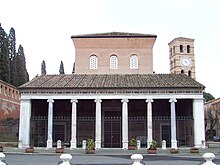San Lorenzo fuori le mura
| Papal Basilica of Saint Lawrence outside the Walls Basilica Papale di San Lorenzo fuori le Mura Template:It icon | |
|---|---|
 The Basilica di San Lorenzo fuori le Mura is a shrine to the martyred Roman deacon, Saint Lawrence. The facade was rebuilt after being devastated by an Allied bombing on July 19, 1943. | |
| Religion | |
| Affiliation | Roman Catholic |
| Province | Diocese of Rome |
| Ecclesiastical or organizational status | Papal minor basilica, parish church |
| Leadership | P. Bruno Mustacchio |
| Location | |
| Location | Rome, Italy |
| Geographic coordinates | 41°54′09″N 12°31′14″E / 41.90250°N 12.52056°E |
| Architecture | |
| Type | Church |
| Groundbreaking | 4th century |
| Specifications | |
| Direction of façade | WbS |
| Length | 90 metres (300 ft) |
| Width | 25 metres (82 ft) |
| Width (nave) | 14 metres (46 ft) |
| Website | |
| www | |
The Papal Basilica of Saint Lawrence outside the Walls (Template:Lang-it) is a Roman Catholic parish church and minor basilica, located in Rome, Italy. The basilica is one of the Seven Pilgrim Churches of Rome and one of the five Patriarchal basilicas, each of which is assigned to a patriarchate. St. Lawrence outside the Walls is assigned to the Patriarchate of Jerusalem.
The papal[1] basilica is the shrine tomb of the church's namesake, Saint Lawrence, one of the first seven deacons of Rome martyred in 258. Pope Pius IX, who has been beatified, is also buried at the basilica.
History
Before the present-day basilica was constructed, the estate upon which it sits was once home to a small oratory built by Emperor Constantine I. The emperor built it over the site on which it was believed that Saint Lawrence was executed. In the 580s, Pope Pelagius II commissioned the construction of a church over the site, in honor of the martyr. In the 13th century, Pope Honorius III commissioned the construction of another church in front of the older structure. It was adorned with frescoes depicting the lives of Saint Lawrence, and the first martyred deacon Saint Stephen, who is interred with Lawrence in the confessio under the high altar. The two structures were united as part of a program of urban renewal. Excavations have revealed several other crypts of various people, buried below street level. Saint Hilarius is buried here.
The portico, c. 1220, has Cosmatesque decoration by the Vassaletti family of craftsmen. The 13th-century frescoes, which have been recently reconstructed, depict scenes from the lives of St Stephen and St Lawrence, both deacons and martyrs.
There are two ancient sarcophagi in the portico. A Christian one, possibly decorated in the 7th century on an older sarcophagus, has a relief depicting putti picking grapes. While vines and grapes are symbols of the Eucharist, this is not likely here. Two Romanesque stone lions were moved here from the old entrance.
The campanile was built in the 12th century. Just inside the entrance is the tomb of Guglielmo Cardinal Fieschi, died 1256, but entombed in an ancient sarcophagus, incidentally decorated with a relief depicting a pagan marriage feast.
The choir enclosure and pulpit has Cosmatesque decoration, and there is also a fine Cosmatesque Paschal candlestick made in the 12th or 13th century.
The antique Ionic capital on the column directly behind the pulpit has carvings of a frog and a lizard. On the triumphal arch are Byzantine mosaics from the 6th century, depicting Christ with saints. The confessio is below the high altar, and can be entered from the nave. Here, St Lawrence and St Stephen are enshrined. The latter was brought here from Constantinople by Pope Pelagius II when he restored the church. Behind the high altar is a papal altar with an inscription naming the makers, of the Cosmati family, and dating it to 1148.
In more recent history, the Basilica di San Lorenzo fuori le Mura was home to the Latin Patriarch of Jerusalem from 1374 to 1847. In 1943, the church was bombed during World War II. Restoration lasted until 1948, allowing some 19th-century accretions to be removed; however, the frescoes on the facade were lost.
Burials
- Roman deacon martyr Saint Lawrence
- Proto-martyr St. Stephen
- Pope Pius IX
- Italian Prime Minister Alcide De Gasperi, a founding father of the European Union, has a tomb near the entrance sculpted by Giacomo Manzù.
- St. Pope Hilarius
Notes
- ^ Benedict XVI’s theological act of renouncing the title of "Patriarch of the West" had as consequence that Roman Catholic patriarchal basilicas are today officially known as Papal basilicas.
Bibliography
- Mondini, Daniela, S. Lorenzo fuori le mura, in: P. C. Claussan, D. Mondini, D. Senekovic, Die Kirchen der Stadt Rom im Mittelalter 1050-1300, Band 3 (G-L), Stuttgart 2010, pp. 317–527, ISBN 978-3-515-09073-5
- Webb, Matilda (2001). "San Lorenzo Fuori le Mura and Catacomb". The Churches and Catacombs of Early Christian Rome. Brighton: Sussex Academic Press. pp. 240–245. ISBN 1-902210-58-1.
- A. Muñoz, La Basilica di S.Lorenzo fuori le mura, Roma 1944.
- G. Da Bra, S.Lorenzo fuori le mura, Roma 1952
- R. Krautheimer, Corpus basilicarum christianarum Romae, S.Lorenzo fuori le mura, Città del Vaticano 1962.
External links
- The Vatican: spirit and art of Christian Rome, a book from The Metropolitan Museum of Art Libraries (fully available online as PDF), which contains material on the Basilica
